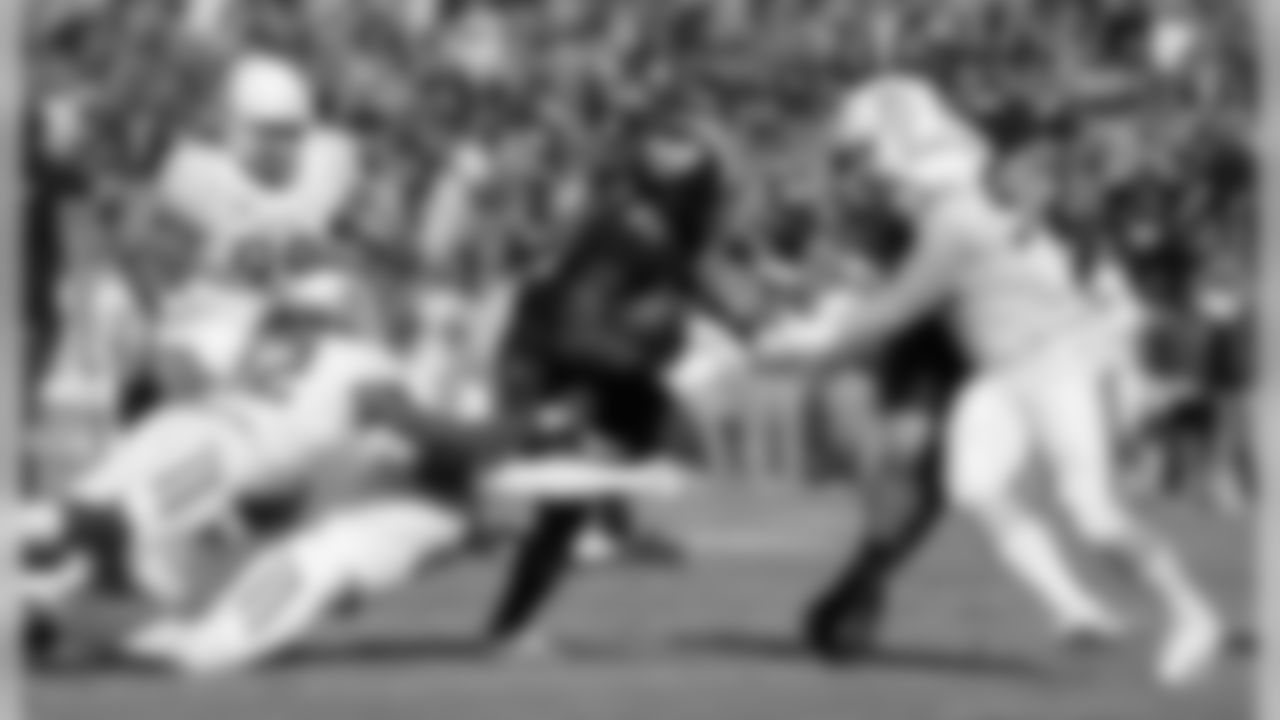Do you have a comment or question? Send it to the vikings.com Mailbag! Every Monday we'll post several comments and/or questions as part of the vikings.com Monday Morning Mailbag. Although we can't post every comment or question, we will reply to every question submitted.
Click here to submit a comment or question to the mailbag. Remember to include your name and town on the email. The questions below have been edited for clarity.
Vikings Team Reporter Eric Smith usually handles the Mailbag, but he's on vacay this week, so I'm happy to pinch hit.
Curious as to what is taking the Vikings so long to sign their draft picks? If it's based off draft status on what they get paid, it should be set in stone and done by now correct? Thank you.
— Cory in Green Bay, Wisconsin
Cory, thanks for checking on this and supporting the Purple while living in the home of Minnesota's road Border Battle destination.
You're right that there's a general structure for compensation based on order of selection.
Because COVID-19 shifted the the offseason program to a virtual experience with no on-field workouts, the draft picks did not come to Minnesota. A few formalities still need to occur, such as undergoing a physical by the team's medical staff, before officially putting pen to paper.
We don't yet have an official start date for Verizon Vikings Training Camp, but we will be sure to bring you that information and coverage of the action when we can. There could be a flurry of signing announcements once it is go time.
The good thing is that the rookies were able to participate in the virtual offseason program and should be able to hit the ground running.
View images of all of the Minnesota Vikings 2020 NFL Draft picks.








CB Jeff Gladney





Boise State offensive lineman Ezra Cleveland (76) on the sidelines during the first half of an NCAA college football game against Hawaii, Saturday, Oct. 12, 2019, in Boise, Idaho. Boise State won 59-37. (AP Photo/Steve Conner)

CORRECTS DATELINE TO TALLAHASSEE, FLA., INSTEAD OF ORLANDO, FLA. - Boise State running back Robert Mahone (34) is lifted in congratulations by offensive lineman Ezra Cleveland (76) for scoring the winning touchdown during the fourth quarter of an NCAA college football game against Florida State, Saturday, Aug. 31, 2019 in Tallahassee, Fla. (AP Photo/Gary McCullough)

Boise State offensive lineman Ezra Cleveland, left, battles against Hawaii defensive lineman Kaimana Padello, right, in the first half of an NCAA college football game, Saturday, Oct. 12, 2019, in Boise, Idaho. Boise State won 59-37. (AP Photo/Steve Conner)

Mississippi State defensive back Cameron Dantzler (3) defends on a pass play against Arkansas during an NCAA college football game, Saturday, Nov. 2, 2019 in Fayetteville, Ark. (AP Photo/Michael Woods)

Mississippi State defensive back Cameron Dantzler runs a drill at the NFL football scouting combine in Indianapolis, Sunday, March 1, 2020. (AP Photo/Michael Conroy)

Mississippi State cornerback Cameron Dantzler (3) returns an interception against Louisiana-Lafayette during the first half of an NCAA college football game in New Orleans, Saturday, Aug. 31, 2019. (AP Photo/Chuck Cook)

Mississippi State cornerback Cameron Dantzler (3) defends Louisiana-Lafayette wide receiver Ja'Marcus Bradley (2) in the second half of an NCAA college football game in New Orleans, Saturday, Aug. 31, 2019. Mississippi State won, 38-28. (AP Photo/Chuck Cook)

Mississippi State assistant coach Terrell Buckley talks to cornerback Cameron Dantzler (3) in the second half of their NCAA college football game against Louisiana-Lafayette in New Orleans, Saturday, Aug. 31, 2019. Mississippi State won, 38-28. (AP Photo/Chuck Cook)

FILE - In this Saturday, Nov. 11, 2017, file photo, Florida quarterback Feleipe Franks (13) attempts to elude South Carolina defensive lineman D.J. Wonnum (8) during the second half of an NCAA college football game in Columbia, S.C. The Southeastern Conference is filled with young quarterbacks this season, with many teams putting their offenses in the hands of freshmen or sophomores. (AP Photo/Sean Rayford, File)

South Carolina defensive lineman D.J. Wonnum (8) pursues Florida quarterback Malik Zaire (8) during the first half of an NCAA college football game Saturday, Nov. 11, 2017, in Columbia, S.C. South Carolina defeated Florida 28-20. (AP Photo/Sean Rayford)

South Carolina defensive lineman D.J. Wonnum (8) and Taylor Stallworth (90) react after a play during the first half of an NCAA college football game against Clemson on Saturday, Nov. 25, 2017, in Columbia, S.C. Clemson defeated South Carolina 34-10. (AP Photo/Sean Rayford)

Tennessee running back John Kelly (4) runs for yardage as South Carolina defensive lineman D.J. Wonnum (8) chases in the first half of an NCAA college football game Saturday, Oct. 14, 2017, in Knoxville, Tenn. (AP Photo/Wade Payne)

Florida quarterback Austin Appleby (12) is stopped for a 1-yard loss by South Carolina defensive lineman Kelsey Griffin, left, and defensive lineman D.J. Wonnum, right, during the first half of an NCAA college football game, Saturday, Nov. 12, 2016, in Gainesville, Fla. (AP Photo/John Raoux)



TCU running back Kyle Hicks (21) looks for room against Baylor safety Davion Hall (12) and Baylor defensive tackle James Lynch (93) during the first half of an NCAA college football game, Friday, Nov. 24, 2017, in Fort Worth, Texas. TCU won 45-22. (AP Photo/Brandon Wade)

Baylor defensive tackle James Lynch (93) sacks West Virginia quarterback Will Grier (7) in the first half of an NCAA college football game, Saturday, Oct. 21, 2017, in Waco, Texas. (AP Photo/Jerry Larson)

Rice quarterback Wiley Green (5) pitches out to wide receiver Cameron Montgomery (8) as Baylor defensive tackles Bravvion Roy, left, and defensive tackle James Lynch close in during the first half of an NCAA college football game Saturday, Sept. 21, 2019, in Houston. (AP Photo/Michael Wyke)

Oregon linebacker Troy Dye (35) dives and sacks Utah quarterback Troy Williams (3) in the first half of an NCAA college football game, Saturday, Nov. 19, 2016, in Salt Lake City. (AP Photo/George Frey)

Colorado running back Phillip Lindsay (23), blows past Oregon linebacker Troy Dye (35), in an NCAA college football game Saturday, Sept. 24, 2016 in Eugene, Ore. (AP Photo/Thomas Boyd)

Oregon linebacker Troy Dye (35), celebrates an interception that set up a last minute second quarter touchdown against Arizona State in an NCAA college football game Saturday, Oct. 29, 2016 in Eugene, Ore. (AP Photo/Thomas Boyd)






Temple cornerback Harrison Hand (23) stops Maryland place kicker Mike Shinsky (41) on the fake field goal during the first half of an NCAA college football, Saturday, Sept. 14, 2019, in Philadelphia. Temple won 20-17. (AP Photo/Chris Szagola)

Memphis wide receiver Damonte Coxie (10) gets tackled by Temple cornerback Harrison Hand (23) to end the second half of an NCAA college football, Saturday, Oct. 12, 2019, in Philadelphia. Temple won 30-28. (AP Photo/Chris Szagola)


Miami wide receiver K.J. Osborn runs against Florida after a reception during the second half of an NCAA college football game, Saturday, Aug. 24, 2019, in Orlando, Fla. (AP Photo/John Raoux)

Miami wide receiver K.J. Osborn (2) sets up for a play at the line of scrimmage during the second half of an NCAA college football game against Florida Saturday, Aug. 24, 2019, in Orlando, Fla. (AP Photo/Phelan M. Ebenhack)

Miami wide receiver K.J. Osborn, center, fumbles the ball as he is hit by Florida linebacker Jonathan Greenard, left, and defensive back Shawn Davis during the second half of an NCAA college football game, Saturday, Aug. 24, 2019, in Orlando, Fla. (AP Photo/John Raoux)

Miami wide receiver K.J. Osborn runs against Florida after a reception during the second half of an NCAA college football game, Saturday, Aug. 24, 2019, in Orlando, Fla. (AP Photo/John Raoux)



Oregon State Beavers offensive lineman Blake Brandel (73) warms up before the first half of an NCAA college football game against the on Saturday, Aug. 26, 2017, in Fort Collins, Colo. (AP Photo/David Zalubowski)

Oregon State offensive lineman Blake Brandel, left, blocks Washington State defensive lineman Kingston Fernandez (52) during the second half of an NCAA college football game in Pullman, Wash., Saturday, Sept. 16, 2017. (AP Photo/Young Kwak)

Oregon State Beavers offensive lineman Blake Brandel (73) warms up before the first half of an NCAA college football game against the on Saturday, Aug. 26, 2017, in Fort Collins, Colo. (AP Photo/David Zalubowski)

Michigan defensive back Josh Metellus (14) celebrates a play in the second half of an NCAA college football game against Indiana in Ann Arbor, Mich., Saturday, Nov. 17, 2018. (AP Photo/Paul Sancya)

Florida quarterback Feleipe Franks (13) runs out of the pocket against Michigan defensive back Josh Metellus (14) during the first half of the Peach Bowl NCAA college football game, Saturday, Dec. 29, 2018, in Atlanta. (AP Photo/Mike Stewart)

Michigan defensive back Josh Metellus (14) tackles Florida running back Lamical Perine (22) during the first half of the Peach Bowl NCAA college football game, Saturday, Dec. 29, 2018, in Atlanta. (AP Photo/John Bazemore)

Michigan defensive back Josh Metellus, left, runs Ohio State receiver Parris Campbell out-of-bounds during the first half of an NCAA college football game Saturday, Nov. 24, 2018, in Columbus, Ohio. (AP Photo/Jay LaPrete)

Middle Tennessee quarterback Chase Cunningham (16) throws a pass, defended by Michigan defensive back Josh Metellus (14), in the third quarter of an NCAA football game in Ann Arbor, Mich., Saturday, Aug. 31, 2019. Michigan won 40-21. (AP Photo/Tony Ding)

FILE - In this Oct. 20, 2018, file photo, Michigan State defensive end Kenny Willekes rushes the line during the second half of an NCAA college football game against Michigan in East Lansing, Mich. Ohio State visits Michigan State needing a win to stay on track for a Big Ten East showdown with Michigan in two weeks. (AP Photo/Carlos Osorio, File)

Ohio State quarterback Dwayne Haskins is sacked by Michigan State defensive end Kenny Willekes (48) during the first half of an NCAA college football game, Saturday, Nov. 10, 2018, in East Lansing, Mich. (AP Photo/Carlos Osorio)

Michigan State defensive end Kenny Willekes (48) recovers a fumble for a turnover by Nebraska quarterback Adrian Martinez (2) during the first half of an NCAA college football game in Lincoln, Neb., Saturday, Nov. 17, 2018. (AP Photo/Nati Harnik)

Nebraska quarterback Adrian Martinez (2) carries the ball in front of Michigan State defensive end Kenny Willekes (48) during the first half of an NCAA college football game in Lincoln, Neb., Saturday, Nov. 17, 2018. (AP Photo/Nati Harnik)

Michigan State's Kenny Willekes reacts against Ohio State during the first quarter of an NCAA college football game, Saturday, Nov. 10, 2018, in East Lansing, Mich. (AP Photo/Al Goldis)

Penn State linebacker Ellis Brooks, center, pressures as Iowa quarterback Nate Stanley pulls back to pass during the first half of an NCAA college football game, Saturday, Oct. 12, 2019, in Iowa City, Iowa. (AP Photo/Matthew Putney)

Iowa quarterback Nate Stanley gets set during the first half of an NCAA college football game, Saturday, Oct. 12, 2019, in Iowa City, Iowa. (AP Photo/Matthew Putney)

Iowa quarterback Nate Stanley warms up before an NCAA college football game against Purdue, Saturday, Oct. 19, 2019, in Iowa City, Iowa. (AP Photo/Charlie Neibergall)

Iowa quarterback Nate Stanley, left, talks with the offense in a huddle during the first half of an NCAA college football game, Saturday, Oct. 12, 2019, in Iowa City, Iowa. (AP Photo/Matthew Putney)

Iowa quarterback Nate Stanley (4) passes against Northwestern during the first half of an NCAA college football game, Saturday, Oct. 26, 2019, in Evanston, Ill. (AP Photo/David Banks)

Mississippi State defensive back Brian Cole II (32) warms up before an NCAA football game on Saturday, Sept. 14, 2019 at Mississippi St. in Starkville, Miss. (AP Photo/Vasha Hunt)

Mississippi State Bulldogs Cameron Dantzler (3) celebrates his interception with teammates Brian Cole II (32) and Chauncey Rivers (5) during the first half of an NCAA college football game against Louisiana Lafayetter in New Orleans, Saturday, Aug. 31, 2019. (AP Photo/Chuck Cook)

Mississippi State defensive back Brian Cole II (32) reacts during the first half of an NCAA football game on Saturday, Sept. 14, 2019 at Mississippi St. in Starkville, Miss. (AP Photo/Vasha Hunt)

Mississippi State quarterback Garrett Shrader (6) passes while safety Brian Cole (32) defends during the team's spring NCAA college football game in Starkville, Miss., Saturday, April 13, 2019. (AP Photo/Rogelio V. Solis)


I was brainstorming options for the eventual 17-game schedule, if the NFL decides to go with one in 2021 and beyond. I came up with a format that you and others might find interesting.
First, the baseline assumptions: each team will play an 8-home/9-away or 9-home/8-away schedule that alternates every year. This cycle will match up with the new 3-game preseason schedule and continue to result in a total of 10 home games per year, the way things have been done for quite a while.
So, my idea for a 17-game schedule is as follows:
4 interconference games (2 home and 2 away) against one of four divisions in the other conference in the existing rotation — unchanged from current practice
4 intraconference games (2 Home and 2 away) against one of three divisions in the same conference in the existing rotation — again, unchanged from current practice
4 more intraconference games against the remaining 2 divisions within the conference that are not matched up already in the standard intraconference divisional matchup (2 home and 2 away). These four games would be determined based on the previous season's standings as follows: the first and second place teams face off against each other in each of the 2 remaining non-rotational divisions. Likewise, the third and fourth place teams would face off. One home and away game in each non-rotational division
That totals 12 games so far.
The final 5 games would be divisional games where each team in a division plays 2 of their divisional rivals twice (one home and one away). The fifth divisional game is the lone matchup for the season against the remaining divisional team. That game would be either home or away and alternate each year both from an opponent perspective and a location perspective. It would be this 5th divisional game each year that would determine whether the team was playing 9 home and 8 away, or vice versa, for that season. The single-matchup team would not rotate on a 2-year cycle, but would change each season. This results in a 6-year cycle for divisional matchups that actually is pretty well-rounded. Here is an example for Vikings divisional opponents using my idea:
Year 1: 2 games each with Bears and Lions; Packers away
Year 2: 2 games each with Lions and Packers; Bears at home
Year 3: 2 games each with Packers and Bears; Lions away
Year 4: 2 games each with Bears and Lions; Packers at home
Year 5: 2 games each Lions and Packers; Bears away
Years 6: 2 games Packers and Bears; Lions at home
I think this formula allows for more and better matchups within a conference each year. The value and importance of the lone game against a divisional opponent would be huge — and not negatively impact tiebreaking procedures either. Currently, 6 teams are not played each year within a conference. This format reduces that to only four teams not played and results in more big conference matchups.
Combining the 17th game with a reduction of one divisional game results in a more balanced and interesting intraconference schedule. And in my opinion does not degrade the division schedule all that much.
— Jeff Ludwig
As Jeff mentioned, you may remember that the Collective Bargaining Agreement for 2021-30 was approveded in mid-March. Included in the agreement is the option for a 17th regular-season game as early as 2021 and possibly reducing the preseason to three games.
I'd think that the baseline assumption for the number of home and away games (rotating between eight and nine each year) is probably on good footing because it seems the most equitable approach. Although it's not an apples-to-apples, if teams hosted nine regular-season games, they could wind up with just one preseason home game to keep that number at 10.
His idea for how to handle the odd number of games by taking away a division game and applying it and the extra game to create more conference games is interesting for a couple of reasons.
I love the idea of not having to go through multiple tiebreakers to crown a division winner, and an odd number of games could help avoid that. I also like the idea of having so many conference games now that the playoffs have been expanded to seven teams per conference, a change set to apply in 2020.
A possible drawback, however, is teams might lament not getting to play every division opponent at home and away in a season. Much of the passion is built on divisional rivalries.
I'll have no say what so ever — it's between NFL Owners and the NFL Players Association — but I wouldn't mind seeing an additional interconference game on a rotational basis. As it is right now, an NFC team only hosts an AFC team every eight seasons, which reduces the opportunity to see some marquee players in person to just once — or maybe twice in some rare cases — in their entire career.
NFL Owners and the NFLPA have some more urgent matters for 2020, but I really appreciate the hypothetical from Jeff.
The following suggestion for the Vikings was submitted via Twitter instead of the Mailbag, but why not include?
Bryant has three Pro Bowls, nearly 7,500 career receiving yards and 73 touchdowns to his credit, but he hasn't played in a game since the end of the 2017 season.
There are definitely some household names on the free-agent market, and it will be interesting to see the dominoes fall at a time when rosters have usually been set.
Can you name the three Hall of Fame WRs that were with the Vikings in 1998? Trick question.
Hint #1: One WR isn't in the HOF yet. But he will be.
Hint #2: One WR wasn't on the active roster and never actually played for the Vikings.
Answer: Cris Carter — veteran, Randy Moss — rookie, Larry Fitzgerald — ball boy
All were 'with' the Vikings in 1998.
Skol!
— Jeff Kilty in Sacramento, California
Many people automatically think "3 Deep" quickly when they reminisce about 1998 because of what Carter, Moss and Jake Reed were able to do to defenses, but that season was so special that even a ball boy is bound for Canton.
Talk about a quality internship of sorts for Fitzgerald, who turned 15 that August. One could even qualify it as advanced degree. I love the old photos of Fitzgerald roaming the practice field, combined with what he's been able to achieve to join elite company.
The trio of Carter (eight), Moss (six) and Fitzgerald (11) have combined for 25 Pro Bowls, and Carter and Fitzgerald each earned Walter Payton NFL Man of the Year awards.
Fitzgerald now ranks second on the all-time receiving yards list with 17,083. Moss is now fourth at 15,292, and Carter is 13th with 13,899.
The understudy is also second all-time with 1,378 catches. Carter ranks sixth at 1,101, and Moss is 15th at 982.
As far as touchdowns, Moss ranks second with 156, Carter is fourth with 130, and Fitzgerald is sixth at 120. That's a lot of playmaking in the paint.






















